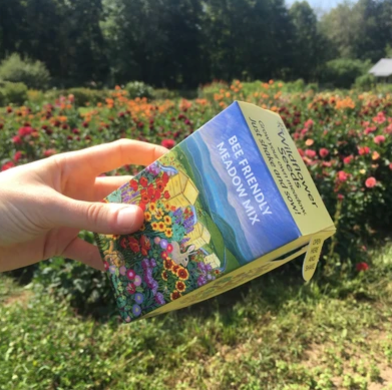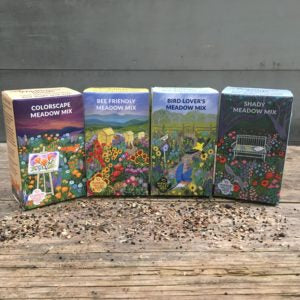
Grow-How: Save The World One Meadow At A Time
You've probably heard a lot of talk about pollinators recently: save the bees, save the monarchs, pollinator gardens, milkweed... Talk of pollinators is as profuse as pollen. And while planting pollinator-friendly plants may seem like the trendy thing to do, the insects and animals that support our natural systems are more than just a fad.
Pollinators help to produce about three quarters of the world’s cultivated crops and about 80% of all flowering plants. Without bees, wasps, bats, butterflies, beetles, flies, and hummingbirds, our gardens and our pantries would be mostly bare. It's important to remember that, not only do human diets and economies depend on the well-being of pollinator populations, but also that global ecosystems in general need them, and that those supporting species are valuable in their own right.
 To remind people of the beauty that is a world with pollinators, and to help you join the cause of creating pollinator habitats, we created our Wildflower Seed Shakers. With a flick of the wrist, pollinator power can now be in the hands of anyone! Each box contains a mix of flower varieties and enough seed and vermiculite to sow 100 square feet of pollinator paradise. To truly convey the magic of a flower meadow, we worked with artist Cynthia Cliff to create four beautiful works of art. To read more about Cynthia's artistic process, read our interview with her.
To remind people of the beauty that is a world with pollinators, and to help you join the cause of creating pollinator habitats, we created our Wildflower Seed Shakers. With a flick of the wrist, pollinator power can now be in the hands of anyone! Each box contains a mix of flower varieties and enough seed and vermiculite to sow 100 square feet of pollinator paradise. To truly convey the magic of a flower meadow, we worked with artist Cynthia Cliff to create four beautiful works of art. To read more about Cynthia's artistic process, read our interview with her.
But say you have your seed shaker, you're ready to give something back to all the birds and bugs, but you're not sure how to start. Never fear! Let's go through the steps of planting a flower meadow together.
To invite pollinators into your growing space, simply meet their basic needs: food, water, and shelter.
Food: Pollinators feed on nectar. The greater the amount of flowering plant varieties, the greater the amount of pollinators that will be attracted. Attracting plants aren’t limited to ornamental flowers; many herb and vegetable blossoms also provide desirable nectar sources. A diverse selection of flowers–of varying shape, size, bloom time, color, and height–will equal a greater diversity, population, and well-being of pollinators.
Water: Pollinators, just like gardeners and plants, need water to survive. Shallow pools with floating elements (for flying pollinators to land on) are ideal–even a small tray or bird bath with a few floating twigs will work. Some pollinators make use of muddy water for providing them with important minerals or even building material (for bee hives), which may make you see the pesky mud puddle in your garden path in a whole new light.
Shelter: While individual plants or plots of pollinator-friendly varieties are doubtlessly beneficial, larger plots or meadows provide not only a source of food, but a safe home and breeding ground as well. Once the meadow is established and there is no risk of it being overtaken by competing plants, a few weeds can actually be beneficial; they will create a safe home for pollinators to lay eggs, grow larvae, and even overwinter.
Timing: Sow your wildflower patch in early to mid-spring. If your flower meadow mix contains perennials, like the Bee Friendly, Bird Lover's, or Shady Meadow Mix Seed Shakers, you can also sow in late fall, and the perennial seeds will establish enough to overwinter and come up the following spring. An annual-heavy mix like Colorscape will do best when sown in springtime.
Bed prep: Prepare the soil as you would for any bed. Clean out the weeds. Aerate with a garden fork if compact, then rake flat.
Sowing: Lift open the spout of your Seed Shaker and spread the seeds out evenly over an area no bigger than 100 square feet. Then press seeds into the soil by walking over the planted area (with flat-soled shoes!) or using a board to pat them down. If the soil is dry, water the seeds in. In fall, soils are usually moist enough without.
Maintaining: Continue watering in spring for a few weeks; again, fall sowings usually don't need it. Weed fastidiously until plants reach 12-18" in height. Be patient; the perennial blooms will get better every year!
We all want to change the world, but sometimes it can feel difficult, discouraging, or impossible. How wonderful is it that we can help sustain beneficial species, secure our natural and man-made systems, and beautify our backyards all at once?








